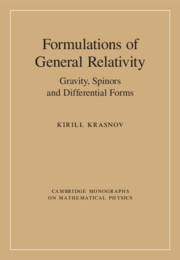Refine listing
Actions for selected content:
17000 results
Frontmatter
-
- Book:
- Formulations of General Relativity
- Published online:
- 06 November 2020
- Print publication:
- 26 November 2020, pp i-vi
-
- Chapter
- Export citation
6 - Chiral Pure Connection Formulation
-
- Book:
- Formulations of General Relativity
- Published online:
- 06 November 2020
- Print publication:
- 26 November 2020, pp 192-249
-
- Chapter
- Export citation
References
-
- Book:
- Formulations of General Relativity
- Published online:
- 06 November 2020
- Print publication:
- 26 November 2020, pp 365-368
-
- Chapter
- Export citation
4 - General Relativity in 2+1 Dimensions
-
- Book:
- Formulations of General Relativity
- Published online:
- 06 November 2020
- Print publication:
- 26 November 2020, pp 125-131
-
- Chapter
- Export citation
Preface
-
- Book:
- Formulations of General Relativity
- Published online:
- 06 November 2020
- Print publication:
- 26 November 2020, pp xiii-xviii
-
- Chapter
- Export citation
Introduction
-
- Book:
- Formulations of General Relativity
- Published online:
- 06 November 2020
- Print publication:
- 26 November 2020, pp 1-7
-
- Chapter
- Export citation
5 - The ‘Chiral’ Formulation of General Relativity
-
- Book:
- Formulations of General Relativity
- Published online:
- 06 November 2020
- Print publication:
- 26 November 2020, pp 132-191
-
- Chapter
- Export citation
1 - Aspects of Differential Geometry
-
- Book:
- Formulations of General Relativity
- Published online:
- 06 November 2020
- Print publication:
- 26 November 2020, pp 8-77
-
- Chapter
- Export citation

Formulations of General Relativity
- Gravity, Spinors and Differential Forms
-
- Published online:
- 06 November 2020
- Print publication:
- 26 November 2020
1 - Gravity Triumphant
-
- Book:
- Gravity's Fatal Attraction
- Published online:
- 29 September 2020
- Print publication:
- 05 November 2020, pp 1-22
-
- Chapter
- Export citation
6 - Jets
-
- Book:
- Gravity's Fatal Attraction
- Published online:
- 29 September 2020
- Print publication:
- 05 November 2020, pp 131-168
-
- Chapter
- Export citation
8 - Black Holes in Hibernation
-
- Book:
- Gravity's Fatal Attraction
- Published online:
- 29 September 2020
- Print publication:
- 05 November 2020, pp 187-212
-
- Chapter
- Export citation
2 - Stars and Their Fates
-
- Book:
- Gravity's Fatal Attraction
- Published online:
- 29 September 2020
- Print publication:
- 05 November 2020, pp 23-50
-
- Chapter
- Export citation
7 - Blasts from the Past
-
- Book:
- Gravity's Fatal Attraction
- Published online:
- 29 September 2020
- Print publication:
- 05 November 2020, pp 169-186
-
- Chapter
- Export citation
Appendix: Gravity and Cosmic Dimensions
-
- Book:
- Gravity's Fatal Attraction
- Published online:
- 29 September 2020
- Print publication:
- 05 November 2020, pp 293-296
-
- Chapter
- Export citation
9 - Cosmic Feedback
-
- Book:
- Gravity's Fatal Attraction
- Published online:
- 29 September 2020
- Print publication:
- 05 November 2020, pp 213-232
-
- Chapter
- Export citation
Frontmatter
-
- Book:
- Gravity's Fatal Attraction
- Published online:
- 29 September 2020
- Print publication:
- 05 November 2020, pp i-iv
-
- Chapter
- Export citation
3 - Black Holes in Our Backyard
-
- Book:
- Gravity's Fatal Attraction
- Published online:
- 29 September 2020
- Print publication:
- 05 November 2020, pp 51-72
-
- Chapter
- Export citation
4 - Galaxies and Their Nuclei
-
- Book:
- Gravity's Fatal Attraction
- Published online:
- 29 September 2020
- Print publication:
- 05 November 2020, pp 73-108
-
- Chapter
- Export citation
12 - Through the Horizon
-
- Book:
- Gravity's Fatal Attraction
- Published online:
- 29 September 2020
- Print publication:
- 05 November 2020, pp 269-292
-
- Chapter
- Export citation
